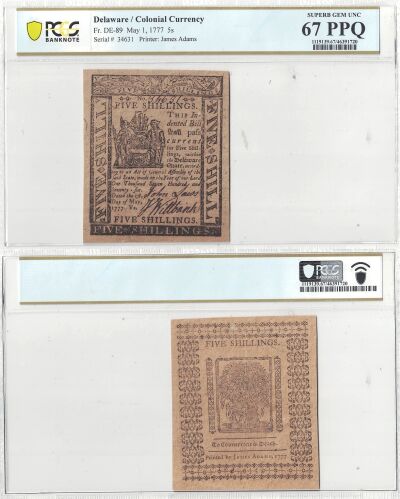Colonial Currency
Faced with a coinage shortage, the British Colonies in North America began issuing their own paper currency in the early 1700's. These notes were denominated first in British pounds and shillings, and later in U.S. dollars. Some early issues were printed by Benjamin Franklin; some others were signed by officials who later signed the Declaration of Independence.
After independence was declared in 1776, the United Colonies, and later the United States, issued paper currency under the authority of the Continental Congress. These fascinating pieces of our colonial heritage are wonderful additions to any collection and are truly historical!
- Found 11 items
 January 14, 1779. CC. Thirty Dollars. PMG. AU-53.$975.00
January 14, 1779. CC. Thirty Dollars. PMG. AU-53.$975.00CC-93. A lovely note with good color, bright paper, and bold signatures.
Item #251305 (1 / 11) 10/25/1775. PA. Two Shillings. PMG. Gem-65. EPQ.$1,225.00
10/25/1775. PA. Two Shillings. PMG. Gem-65. EPQ.$1,225.00PA-187. A fresh example with bright premium paper and dark black ink. Signatures are sharp with a bold appearance. Margins are full and well balanced. Eye appeal is excellent and only a single note grades finer at PMG.
Item #251270 (2 / 11) 12/31/1763. NJ. Three Shillings. PMG. Ch Unc-64. E$599.00
12/31/1763. NJ. Three Shillings. PMG. Ch Unc-64. E$599.00NJ-154. An attractive note with a fresh and bright appearance. Signatures are bold and eye appeal is strong.
Item #242400 (3 / 11) 2/17/1776. CC. $1/3. PCGS. VF-30.$750.00
2/17/1776. CC. $1/3. PCGS. VF-30.$750.00CC-20. Fugio sundial with 'Mind Your Business' motto. A solid note with good ink and paper has plenty of remaining brightness. The signature and serial number are faded but still visible. Wear is light and even.
Item #250923 (4 / 11) 3/16/1785. PA. Fifteen Shillings. PMG. VF-25.$425.00
3/16/1785. PA. Fifteen Shillings. PMG. VF-25.$425.00PA-271. A pleasing note that exhibits strong ink, solid paper, and 3 nice signatures.
Item #237231 (5 / 11) 3/25/1776. NJ. Eighteen Pence. PMG. Gem-65. EPQ.$895.00
3/25/1776. NJ. Eighteen Pence. PMG. Gem-65. EPQ.$895.00NJ-176. A beautiful example with vibrant red and black inks, bright premium paper, and bold signatures. Margins are well balanced and more than ample. Great eye appeal!
Item #250837 (6 / 11) 4/10/1774. MD. Four Dollars. PMG. Ch VF-35. EPQ.$330.00
4/10/1774. MD. Four Dollars. PMG. Ch VF-35. EPQ.$330.00MD-68. An attractive note with solid ink, premium paper with a fresh appearance, and bold signatures.
Item #250476 (7 / 11) 4/10/1774. MD. One Dollar. PMG. VF-25.$249.00
4/10/1774. MD. One Dollar. PMG. VF-25.$249.00MD-66. Well inked with solid paper and strong signatures.
Item #250573 (8 / 11) 5/1/1777. DE. Five Shillings. PCGS. Superb-67. PPQ$1,695.00
5/1/1777. DE. Five Shillings. PCGS. Superb-67. PPQ$1,695.00DE-89. A simply delightful colonial with broad margins, bold signatures, and fresh paper. The proclamation, 'To Counterfeit is Death' can be found on the back. Excellent eye appeal!
Item #250755 (9 / 11) 9/26/1778. CC. Eight Dollars. PCGS. Ch AU-55.$649.00
9/26/1778. CC. Eight Dollars. PCGS. Ch AU-55.$649.00CC-81. A pleasing note with full borders, good color, bright paper, and a solid signature.
Item #251092 (10 / 11) 9/26/1778. CC. Five Dollars. PCGS. VF-35.$475.00
9/26/1778. CC. Five Dollars. PCGS. VF-35.$475.00CC-79. A fully margined note with good color, lightly worn paper, and strong signatures.
Item #251375 (11 / 11)- 11 items found















